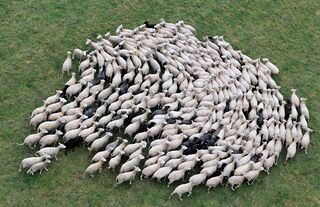Oxytocin
The Biology of Belonging
Why oxytocin is hard to trigger and what you can do
Posted December 29, 2020 Reviewed by Matt Huston

When you see a group of animals, you may think they have the kind of togetherness that you are missing. But the fact is that animals have a lot of drama in their social groups. They create this drama with the limbic brain that we have inherited. It’s easier to understand your social frustrations when you know how it works with animals.
Social support promotes survival, and natural selection built a brain that rewards you with the good feeling of oxytocin when you find social support. When a mammal leaves its group, it feels threatened. This motivates it to return to the good feeling of safety in numbers.
Oxytocin helps create the good feeling that it’s safe to lower your guard. Sharing the burden of vigilance with others allows a mammal to relax enough to fill its belly. But a herd only protects you if you run when the others run. You may not like to be a herd follower, but if you don’t keep track of what others are doing, you can find yourself isolated and in danger. So you run when the others run, even though they have a lot of false alarms.
Life in a herd is not all warm and fuzzy. Sticking with the herd means eating food that others have trampled, and having their horns in your face. You would rather trot off to greener pasture, but when you do, you feel like your survival is threatened. Predators quickly pick off isolated individuals, and the brain built by natural selection warns you with a bad feeling when you get isolated.

It may seem like animals have the nice solidarity that you long for, but it’s useful to know that each member of a herd pushes its way toward the center where it’s safer from predators. When a critter is old, it loses these contests and ends up around the edges where it’s more easily picked off. Mammals stick with the herd despite the drama because to do so is rewarding.
You may have heard that oxytocin is stimulated by touch, but it’s more complicated. Touching someone you don’t trust feels bad. Trust is what really stimulates oxytocin. Touch only stimulates it where trust is already established. Trust is what the mammal brain is really looking for. So how do you know who to trust?
The mammal brain has a simple answer. Neurons connect when oxytocin flows, and that wires you to turn on the good feeling more easily in similar future circumstances. Each brain looks for social trust in ways that worked before. Each mammal looks for its own herd or pack or troop because it may not be accepted in another group, and that could be a survival threat.
The mammalian facts of life may seem harsh, but a reptile’s life is much harsher. Reptiles do not trust their fellow reptile in the way mammals do. They only release oxytocin during sex, for a few seconds. In females, the chemical also triggers the egg-laying muscle. It’s fascinating to know that oxytocin triggers labor contractions and lactation in mammals. We mammals are born into a surge of oxytocin. Our mothers stimulate more by cuddling or licking us. This wires us to turn on the good feeling in similar settings in the future.

Oxytocin circuits help form the basis of attachment. But permanent attachment to mom would not promote the survival of a species. A mammal eventually transfers its attachment from its mothers to its peers. This is a scary time for young mammals, but they have inherited a brain designed to build new attachments.
It would be nice if your oxytocin flowed all the time, but there is no free oxytocin in the state of nature. Our brain evolved to promote survival, not to make you happy all the time. If you released oxytocin all the time, you might trust anyone, anywhere, and that would be a survival risk. Our brain evolved to release the oxytocin more carefully.
Animals spread out when predator threat is low in order to meet their needs in peace. But when predators lurk, they quickly come together. Baboons forget their differences and unite when a lion approaches. Common enemies are the glue that bonds a group. You can see this in human groups quite easily. Listen to the way conversation revolves around common enemies of the people in the conversation. Common enemies distract individuals from the inevitable tensions among mammals.
When you enjoy an oxytocin moment with your fellow mammal, the chemical is quickly metabolized and gone. We’re always looking for ways to stimulate more. Monkeys do that by grooming each other’s fur. You have probably seen images of this, and perhaps wished you had such lovely moments. But behind the romanticized images lies a lot of complexity. In the monkey world, anyone close enough to touch you is close enough to kill you. Monkeys make careful decisions about who they let get close to them.
The survival brain balances risk against reward. It is looking for reciprocity. The individual you groom may not groom you back, but they may do something else for you someday. They may include you in a mating opportunity or protect you in a moment of threat.

But these social alliances can ensnare you in conflict. A baboon is expected to risk its life when a grooming partner calls for help, but that partner may fail to come when it is in need. Sometimes, groups split, and the monkey you groomed yesterday treats you like an enemy today. Cortisol is released when a monkey’s social expectations are disappointed. The bad feeling of cortisol motivates a monkey to look for another troop mate to groom. Neurons connect when cortisol flows, and that wires you to withhold trust in similar future circumstances. It’s not easy being a mammal!
Primates have the advanced skill of building one-to-one bonds in addition to group bonds. The primate brain makes decisions about where to invest its grooming effort. Trust builds in small steps because every mammal has social disappointments. Each small act of trust triggers oxytocin and helps build a new oxytocin pathway. With repetition, we can build new social alliances, and it feels good.
If you cling to idealized notions of animal bonds, you may be disappointed by the humans in your life. You will end up with a lot of cortisol. Instead, you can build new trust bonds by taking a small step toward someone, and then another small step. You don’t know if or when they will reciprocate, but if you keep taking small steps, new pathways will eventually build.
If you wait for belonging to come to you, you may wait too long. It’s good to know that our brains are designed to actively build social alliances.
Our children will miss out on oxytocin if they do not learn these skills. If they expect belonging to come to them effortlessly, they might be disappointed. They may blame the world because it’s easier to critique the world than to risk trust in small steps. But we can all learn to celebrate our power to build trust.
Social groups are frustrating, but without them you feel threatened. When you know this is natural, you can relax. Nothing is wrong with you. Nothing is wrong with the world. We’re mammals!




